Fundamental theorem of calculus
The fundamental theorem of calculus is central to the study of calculus. It is the theorem that shows the relationship between the derivative and the integral and between the definite integral and the indefinite integral. It is broken into two parts, the first fundamental theorem of calculus and the second fundamental theorem of calculus.
Background
[change | change source]A definition for derivative, definite integral, and indefinite integral (antiderivative) is necessary in understanding the fundamental theorem of calculus. The derivative can be thought of as measuring the change of the value of a variable with respect to another variable. The definite integral is the net area under the curve of a function and above the x-axis over an interval [a,b].[1] The indefinite integral (antiderivative) of a function f is another function F whose derivative is equal to the first function f.
History
[change | change source]The history of the fundamental theorem of calculus begins as early as the seventeenth century with Gottfried Wilhelm Leibniz and Isaac Newton. Leibniz looked at integration as the sum of infinite amounts of areas that are accumulated. As such, he references the important concept of area as it relates to the definition of the integral. Isaac Newton used geometry to describe the relationship between acceleration, velocity, and distance. This is key in understanding the relationship between the derivative and the integral; acceleration is the derivative of velocity, which is the derivative of distance, and distance is the antiderivative of velocity, which is the antiderivative of acceleration. In 1823, Cauchy defined the definite integral by the limit definition. Also in the nineteenth century, Siméon Denis Poisson described the definite integral as the difference of the antiderivatives [F(b) − F(a)] at the endpoints a and b, describing what is now the first fundamental theorem of calculus. It wasn’t until the 1950s that all of these concepts were tied together to call the theorem the fundamental theorem of calculus.[2]
First Fundamental Theorem of Calculus
[change | change source]The first fundamental theorem of calculus states that if the function f(x) is continuous, then
This means that the definite integral over an interval [a,b] is equal to the antiderivative evaluated at b minus the antiderivative evaluated at a. This gives the relationship between the definite integral and the indefinite integral (antiderivative).[3]
Second Fundamental Theorem of Calculus
[change | change source]The second fundamental theorem of calculus states that if the function f is continuous, then
This means that the derivative of the integral of a function f with respect to the variable t over the interval [a,x] is equal to the function f with respect to x. This describes the derivative and integral as inverse processes. [4]
References
[change | change source]- ↑ “Definite integrals and negative area.” Khan Academy. 2015. June 1, 2015 <https://www.khanacademy.org/math/integral-calculus/indefinite-definite-integrals/definite_integrals/v/definite-integrals-and-negative-area>
- ↑ Bressoud, D. (2011). “Historical reflections on teaching the fundamental theorem of integral calculus.” The American Mathematical Monthly, 118(2), 99-115.
- ↑ Larson, R., & Edwards, B. (2013). Calculus of a Single Variable. Boston: Brooks/Cole, Cengage Learning, pg. 278.
- ↑ Larson, R., & Edwards, B. (2013). Calculus of a Single Variable. Boston: Brooks/Cole, Cengage Learning, pg. 284.



